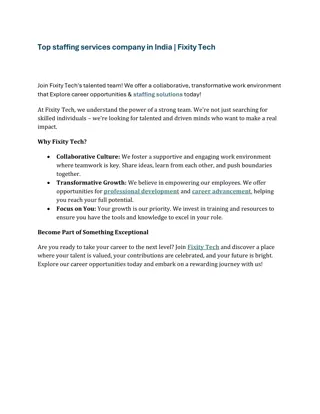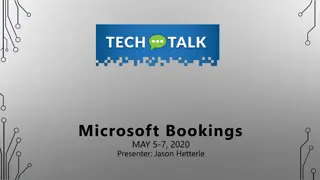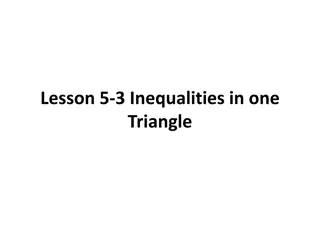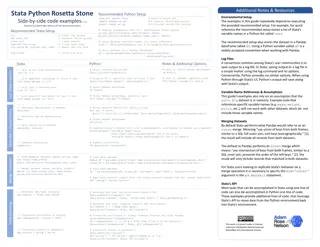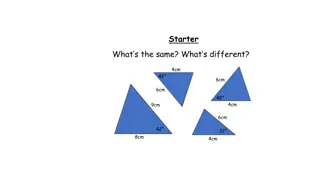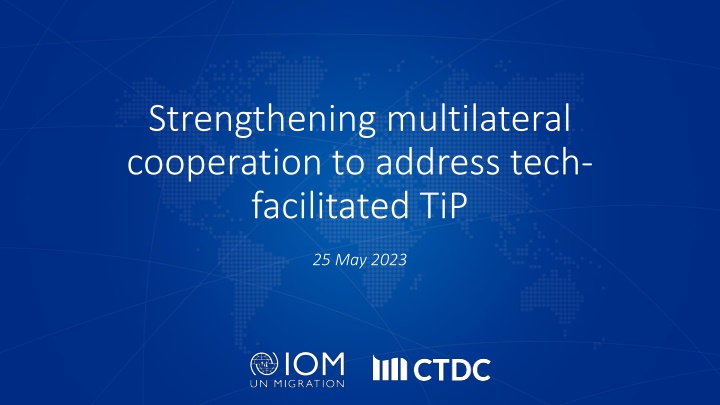
Strengthening Multilateral Cooperation to Address Tech-Facilitated Human Trafficking Data Challenges
Explore the use of technology and data in addressing human trafficking through multilateral cooperation. Learn about case data collection, protection of personal information, and the advantages of synthetic data in ensuring confidentiality and privacy. Discover the differences between raw data and k-anonymized data, as well as examples of synthetic data creation in the fight against human trafficking.
Download Presentation

Please find below an Image/Link to download the presentation.
The content on the website is provided AS IS for your information and personal use only. It may not be sold, licensed, or shared on other websites without obtaining consent from the author. If you encounter any issues during the download, it is possible that the publisher has removed the file from their server.
You are allowed to download the files provided on this website for personal or commercial use, subject to the condition that they are used lawfully. All files are the property of their respective owners.
The content on the website is provided AS IS for your information and personal use only. It may not be sold, licensed, or shared on other websites without obtaining consent from the author.
E N D
Presentation Transcript
Strengthening multilateral cooperation to address tech- facilitated TiP 25 May 2023
Use of tech and data to inform stakeholders Case data Counter-trafficking Data Collaborative (CTDC) Human Trafficking Case Data Standards International Classification Standards on Administrative Data on Trafficking in Persons (ICS-TIP)
Case data IOM and its partners has been providing these direct assistance services to trafficked persons since the mid-1990s Data is systematically collected for the purposes of facilitating delivery of services and for research 100,000 unique case records for vulnerable migrants, including over 50,000 case records for trafficked persons
Internal External Personal data protected and used only internally for service delivery Diversification of data sources - multiple sources of data now available in CTDC Anonymized and synthetic data
What are synthetic data? Synthetic data are artificial data It cannot be linked back to the original data (including cases), so we can ensure data confidentiality and privacy. The statistical properties and relationships from the original data are preserved in synthetic data. The advantages of synthetic data over other forms of data are, e.g., Aggregate data Aggregate data: Researchers can no longer make connections between traits Example: The Global Estimates of Modern Slavery K K- -anonymized data anonymized data: The redaction of outliers can lead to significant data loss Example: CTDC data pre-2021 artificial data generated from real data
Raw Data vs. K-anonymized Data Example Anonymization Raw Data K-anonymized Data (k = 2) Gender Age isForcedLabour Female 19 1 Gender AgeBroad Female 18 20 isForcedLabour k 1 1 Male 18 1 Male 18 20 1 2 Male Male 20 37 1 Male Male 18 20 30 38 1 2 1 Female 35 Female 30 38 2 Female 31 Female 30 38 2
Example: Synthetic Data vs. K-anonymized Data Synthetic Data K-anonymized Data (k = 2) Gender AgeBroad isForcedLabour Gender AgeBroad Female 18 20 isForcedLabour k 1 Female 1 18 20 1 Male 18 20 1 2 Male Male Male 18 20 30 38 1 2 1 30-38 1 Female 30 38 2 Male 18 20 1 Female 30 38 2 Male 18 20 1 *Both datasets are generated from the same raw data. For CTDC, k = 10. Female 30 38 Female 30 38
Overcoming challenges with synthetic data Problem Then Solution Now CTDC s previous solution was labour labour- -intensive and partner intensive and partner reliant reliant K-anonymization results in the loss loss of potentially useful data Risk of re re- -identification and identification and reprisals reprisals Market providers were expensive Microsoft Research s solution automatically automatically prevents the publication of rare attributes Preserves Preserves the statistical properties and relationships in the original data Differential privacy guarantees against any privacy attacks against any privacy attacks Open Open- -source source guarantees expensive
Synthetic Data Tech Against Trafficking Accelerator Program Tech Against Trafficking invited IOM s CTDC to participate the 2019 Accelerator Program. The partnership focused on 3 workstreams: 1. 1. Privacy Privacy- -preserving mechanism preserving mechanism: Develop a solution for analyzing case data while protecting victim privacy. 2. 2. Data standards: Data standards: Address data standards/consistency related to victim case management. 3. 3. Stakeholder engagement: Stakeholder engagement: Maximize utility and impact of the CTDC platform. IOM has benefitted from substantial in-kind support from Microsoft Research to support CTDC.
Global Synthetic Dataset You can download data, codebook, and data dictionary Victim s characteristics, e.g., Country of exploitation Citizenship Type of trafficking, labour exploit, sexual exploit Means of control Trafficking duration and more
Global Victim-Perpetrator Synthetic Dataset You can download data, codebook, and data dictionary Perpetrator characteristics, e.g., Role Region of citizenship Victim- perpetrator relationship Pay money Victim s characteristics, e.g., Type of exploitation Region of exploitation and citizenship
HTCDS Human Trafficking Case Data Standard
Background Background Diverse case management technologies are now accessible to small and large organizations supporting victims on the front line. Human trafficking and case management vary widely and require collaboration and contributions from various organizations. 13
Open data standards are crucial for maintaining consistency across systems and services. Without these standards, there is a risk of divergent definitions and data designs. This can impede process- centric integration efforts and the analysis of aggregated data.
Human Trafficking Case Data Standard Human Trafficking Case Data Standard A global reference for collecting and recording data related to human trafficking cases. Definition Enable organizations worldwide to collect and potentially share information consistently. Goal Organizations handling human trafficking cases, technology services providers, and independent software vendors. Targets Organizations handling human trafficking cases, technology services providers, and independent software vendors. Donors 15
HTCDS Purposes HTCDS Purposes 1. Provide and promote the use of common definitions and language for human trafficking case data 2. Allow more precise comparisons across datasets and geographic regions 3. Support interoperability and data exchange between systems, services, and organizations 4. Enable process-centric integration and aggregate data analysis. For example, with CTDC 5. Encourage the development of new systems and services based on the standard, unlocking innovation 6. Provide tools to accelerate the development of case management systems, reducing their costs
HTCDS Tools HTCDS Tools The HTCDS toolkit is hosted on GitHub, an open The HTCDS toolkit is hosted on GitHub, an open- -source platform that among the field s practitioners among the field s practitioners. . source platform that fosters exchange and feedback fosters exchange and feedback HTCDS is intended to support different case management approaches, enabling companies and HTCDS is intended to support different case management approaches, enabling companies and organizations of various sizes and operating models to utilize HTCDS. organizations of various sizes and operating models to utilize HTCDS. Salesforce Unmanaged Salesforce Unmanaged Package Package XLSForm XLSFormand and Xform Xformsurvey template template survey Microsoft Excel Microsoft Excel 17
IOM and international standardized data on IOM and international standardized data on TiP TiP ICS ICS- -TIP TIP Developed with UNODC. It provides guidance to government agencies for gathering human trafficking data. The aim is to collect high-quality and comparable data to develop evidence-based policies. HTCDS is consistent with ICS-TIP but is intended for civil society organizations. Technical assistance and capacity development Technical assistance and capacity development IOM has developed a survivor case data management training package aligned with the HTCDS, completed with 20 front-line organizations from several countries. Designed through a partnership with Freedom Collaborative and RecollectiV. Contribution to the evidence base on human trafficking, including a research report by Blue Dragon on the vulnerabilities of human trafficking survivors. 18
IOM and international standardized data on TiP E E- -Learning Learning IOM developed a free self-paced e-learning course on case data management for front-line individuals and organizations working on counter-trafficking. The course modules cover various aspects of case data management, including the HTCDS repository and collaborative space, and other available resources. Community of practice Community of practice IOM has created a community of practice focused on data and information management in human trafficking survivor protection. The community has enabled the participation of front-line agencies in the governance and maintenance of the HTCDS and Toolkit, demonstrating the value of the community in the field. 19
Synthetic Data and HTCDS: Relevance to multilateral cooperation Synthetic data, if well used, can strengthen the evidence base on human trafficking More data (that are published safely) can enable more effective research and scalable responses. Victim-perpetrator relationships and victims characteristics can help advance the understanding of risk factors for vulnerability. The technology can be used by any stakeholder who wants to collect and publish sensitive data while protecting individual privacy. HTCDS (and ICS-TIP) IOM focal points can encourage CT collaborators to use data standards and available tools; standard and open-source tools reduce cost! More comparable data will become available over time.
International Organization for Migration International Organization for Migration










